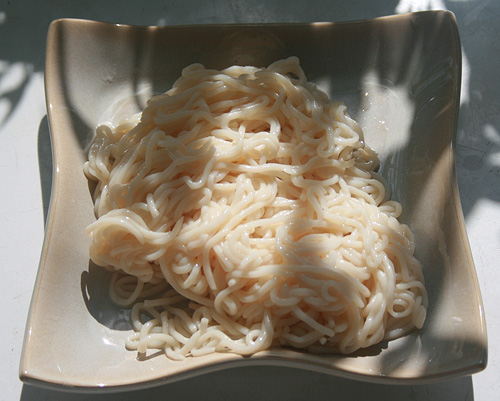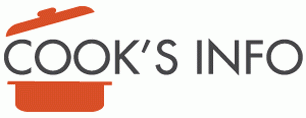 Shirataki Noodles
Shirataki Noodles© Denzil Green
Shirataki Noodles are Japanese noodles not made from wheat or grain. Instead, they are made from Devil’s Tongue Yam flour (aka Konnyaku Powder) and water. This makes them extremely low in calories.
They can come in different shapes such as spaghetti, angel-hair, chunky noodle, etc.
They can be white or black. The white ones are semi-transparent. In Japanese. they are called “shirataki”, meaning “white waterfall.” Solid white ones have tofu added to them, and are called “Tofu Shirataki.” Black ones are used in sukiyaki.
Thick noodles made from yam flour are sold as “Ito konnyaku” (see separate entry.)
All versions of the noodle have almost no flavour. Instead, they absorb the flavours of what they are cooked in, and so are usually used in a saucy dish, such as a soup, or a stir fry that has some sauce in it. The noodles also add a chewy, rubbery, gelatinous texture to a dish. Ones made with tofu in them tend to be less rubbery. That texture is far less noticeable in the spaghetti and angel-hair shape, where the texture comes across more just as properly cooked, al dente noodle.
Shirataki Noodles are sold dried, or packed in water in cans or in bags. The cans are generally 14 oz / 400g, and more expensive than the bags. The bags are generally in the ranges of 7 oz (200g) or 16 oz (450g), and kept in chillers in stores. On brands such as “House Foods”, the “net weight” printed on the bag is the weight you get to work with after the water has been drained off.
Fresh ones are often served tied up in decorative bundles.
These are not the same as Thai Glass Noodles, which are called “Yam Woon Sen.”
Shirataki Noodles are also made in China, but they are more popular in Japan.
Cooking Tips
Shirataki Noodles Package
© Denzil Green
Rinse water-packed ones. The water they are packed in will smell a bit fishy, though a few manufacturers are now making odourless ones. To rinse: drain the noodles into a sieve you’re holding over the sink. Rinse under cold water, then put in a measuring jug or bowl with warm or hot water, swish, then drain. This whole process takes about 60 seconds.
Don’t boil Shirataki Noodles as you would pasta. After rinsing, just add to the dish you are making to let them heat in that during the last 5 minutes of cooking time, or dip in hot water, or steam 3 to 5 minutes. Don’t cook too long or they get too hard to chew.
Don’t cook next to meat: they release calcium ions that can help to toughen meat. Cook separately them combine.
Neither the dried ones nor the water-packed ones will change much in size when heated (they won’t swell up or decrease.)
Nutrition
Very low in carbohydrates. Provide fibre.
|
Amount
|
||
| Calories |
20
|
|
| Fat |
.5 g
|
|
| Cholesterol |
0 mg
|
|
| Carbohydrate |
3 g
|
|
| Fibre |
2 g
|
|
| Sugars |
0 g
|
|
| Protein |
1 g
|
|
Equivalents
1 375 g (13 oz) bag with water = 225 g (8 oz) net weight after being drained = 1 ¼ cup spaghetti-shaped noodles, drained


